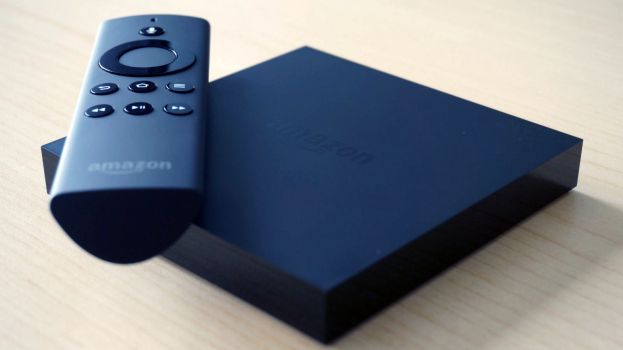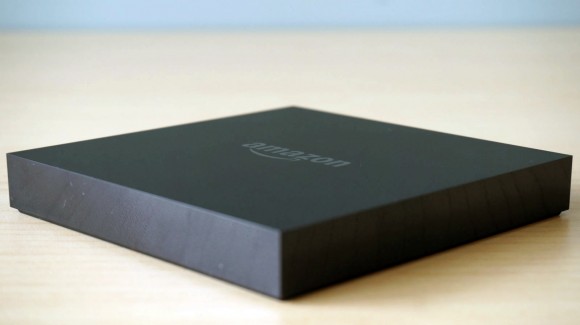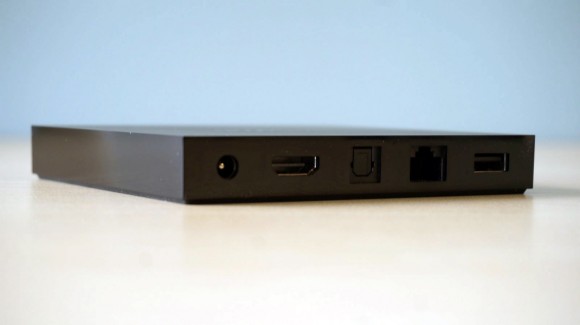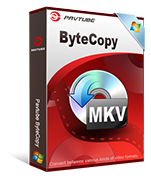With the introduction of Fire TV, Amazon, the behemoth online retailer, has officially entered the streaming set-top box battle that may ultimately decide the future of how we get content into our TVs. The device is competitive on both price and performance with Roku 3, Apple TV and Google Chromecast and seems squarely aimed at challenging those established players. The good news is that the product, like Amazon itself, is friendly, powerful, and innovative and tackles some of the critical consumer pain points associated with the current streaming boxes. The less good news is that it doesn’t entirely live up to some of the promises Amazon is making.

Amazon has explicitly stated that it wanted to address three problem areas about the consumer streaming experience: poor performance, closed ecosystems and cumbersome search. In terms of performance they have a clear winner on their hands. Fire TV is consistently snappy and responsive, thanks to some beefy (for a set top box) silicon inside.

A miniature monolith
In terms of its ecosystem, while Fire TV is a fairly open platform, its interface consistently tilts toward Amazon’s offerings. It can’t access content from iTunes or Google Play (no surprise), but does support a wide array of third party services and will presumably be adding more as time goes on. However, third-party services are relegated to second-class status within Fire TV’s user interface. They sit in the system’s “Apps” tab, while the system’s prominent Movies, TV, Watchlist and My Library tabs all feed directly to Amazon’s offerings. The system’s first party offerings are always in plain view and accessible directly from the home screen. Third-party offerings tend to take some clicking and scrolling to get to.
Search has been addressed with a slick voice recognition feature that uses a microphone on the remote to allow consumers to speak their searches instead of hunting and pecking across an on-screen letter grid. With access to cloud processing to handle the heavy lifting of voice recognition, the system does an excellent job of understanding what you’re trying to tell it. However, voice searches only scan for Amazon and Vevo content, an unfortunate decision that significantly undercuts the utility of this breakthrough feature. Amazon has announced that it will be adding support for searching the catalogs of Hulu Plus, Crackle and Showtime Anytime. However, even with these additions, the device’s tantalizing voice search function remains deeply underpowered.
Amazon has included some compelling extras, including the ability to view photos users have stored on Amazon Cloud Drive, and playback for Music purchased through its MP3 store (coming post-launch). Amazon has also put special focus on games with this system and thanks to a more powerful processor and Amazon’s optional dedicated game controller ($40) Kindle Fire’s gaming options surpass the Angry Birds-level options offered on similar devices. Most games are ports of existing Android titles that already run on the Kindle HDX, but the games not only look and play well on the system, its library of more than 100 titles at launch is quite extensive.
Hardward and design
The box itself is about the size of a small external hard drive, or two CD jewel cases stacked on top of one another. Think of a tiny, squared-off version of the monolith from 2001: A Space Odyssey lying flat. Its exterior is sleek and minimalist, with the only contrast coming from glossy black lettering on a matte black background. At 0.7 inches thick, all of its visual cues seem to be telling you, “Don’t see me.” Its rear side is devoted to the essential ports: power, HDMI, optical audio, Ethernet and USB.

Five ports, no waiting
Under the hood, Fire TV is quite powerful compared to its competitors, sporting a quad-core processor, a discrete GPU and 2GB of RAM. Amazon claims it has three times the processing power of Apple TV, Chromecast or Roku 3, and says it can process 57 billion floating point operations per second. You can wire it into your router via Ethernet, but if that’s inconvenient, Fire TV also packs two dual-band Wi-Fi antennas. All of this adds up to notably snappy menu performance. Movie titles fly by in the interface, transitioning between services is fast and the system handles itself impressively when tasked with rendering games.
The Fire TV’s minimalist matte black remote is similar in functionality to Roku’s, with seven glossy black buttons and a directional selector. It uses Bluetooth to communicate, eliminating line-of sight issues and allowing you to stash the box inside a cabinet or behind a TV. There are buttons for back, home, menu, rewind play/pause and fast forward. Topping the remote on its own is the microphone button that may one day be Fire TV’s secret weapon (but not now, for more on this see the Interface and Search section).

Setup
As with Roku 3 and Apple TV, Fire TV’s setup is eerily simple, and consists of connecting two or three wires (power, HDMI and an optional ethernet cable). If you don’t have it wired to your router, the system will walk you through forging a WiFi connection. As with the Kindle Fire, when you order a Fire TV, Amazon pre-links it to your Amazon account, so after a quick (unskippable) tutorial video you’re immediately able to browse Amazon Instant and Amazon Prime videos along with any photos in your cloud drive. Third party apps must be downloaded and set up separately with their own credentials. In terms of simplicity, the setup process is a win, but its lack of customization options leaves you at the mercy of the one-size-fits-all menu hierarchy Amazon has created (more on this later).

Movies and TV
Naturally, the system provides full-spectrum access to Amazon’s cloud video services, and Amazon Instant and Amazon Prime Video are both well (if not over) represented. At launch, Fire TV offered 40 third-party channels, a far cry from the hundreds available on Roku and Chromecast, but more deals are likely in the works. Amazon did make sure they had the most significant services coming out of the gate, with the notable exceptions of HBO and Aereo. Predictably, iTunes and Google Play are not available on the system, nor are they likely to be.
Amazon is touting Fire TV’s innards as a competitive advantage in terms of movie performance, but while menus move quickly, our tests didn’t uncover much difference in terms of speed to open third party apps or start playing videos as compared with Roku 3 or AppleTV.
Amazon’s native offerings, on the other hand, clearly get a boost from living on their home hardware. First off, all of Amazon’s content is accessible from the main menu of the system’s OS and can start playing without first launching an app. Secondly, Amazon is introducing a feature called ASAP, which is designed to pre-cache video content for you based on your habits and preferences. I saw this in action when I watched the 11th episode of Alpha House (I had previously watched the first 10 episodes, but not on the Fire TV). Impressively, playback began instantaneously when I clicked, with no load time or buffering. Supposedly the system will make more inferences over time as it monitors my actions. It’s a smart, effective system, but as only Amazon’s offerings can use it, it’s one more way the playing field inside Fire TV is tilted to the home team’s advantage.
Music,photos and home movies
Amazon’s official music channel is not yet live, though the company says it will roll out in May 2014. Fire TV currently supports third party music services such as iHeartRadio, Pandora and TuneIn, but these are currently found in the Apps menu, not their own music area. When Amazon’s Music channel goes live, it will allow users to play songs purchased from Amazon’s MP3 store or stored in Cloud Drive.
The photo channel provides a way to access any photos or videos you have stored in Amazon Cloud Drive. Amazon provides a free 5GB of storage for all accounts, and more can be purchased via subscription. The system works simply and seamlessly. You can upload photos from your computer, or use Amazon’s iOS or Android apps to automatically put any photos you take up on the cloud. In addition to letting you page through slide shows, Fire TV can be set to use your images as a screensaver when the system is idle.
Gaming
It’s clear Amazon sees games as a key piece of their strategy with this box. The idea here seems to be to capture casual gamers who aren’t sufficiently invested to buy a $400 to $500 dedicated games console, not a bad bet in a time when mobile gaming is reaching more consumers than ever. Since Fire TV runs the latest version of Amazon’s Fire OS (“Mojito”), which is based on Android, it’s relatively easy for existing Android games to be ported to work on the system and Developers I spoke with from Telltale Games (The Walking Dead) and Mojang (Minecraft) both emphasized how easy it was to move their games onto the platform from their existing games, both of which already run on the Kindle Fire HDX. Amazon has big plans for games, and appears to be actively courting developers and publishers (including EA, Disney, Ubisoft, 2K, Sega and Rockstar) as well as starting up their own in-house design team.

Does this look familiar?
Amazon’s seriousness about gaming is best exemplified by its creation of a dedicated game controller for the system (sold separately, $40). While serviceable, the controller does not show the same polish as the rest of the system. Looking like a cross between an Xbox 360 controller and the Ouyacontroller, the feel of the face buttons and sticks is solid, but its shoulder buttons are a bit stiff and the triggers have a shallow travel that feels unsatisfying. It’s worth noting that many of the games on the system (primarily those with simple tablet-type controls) are playable with only the remote.
Standout titles include Minecraft, The Walking Dead, Terraria, Zen Pinball, You Don’t Know Jack, Badland and the original Sonic The Hedgehog games. Sev Zero, the first in-house game from Amazon Game Studios is an impressive hybrid tower defense/third person shooter that moves surprisingly well for running on a box this small.

The controller also sports all the buttons on the remote (including play/pause, fwd and rew), allowing you to easily manipulate the system’s media options via the controller. While the controller feels substantial in the hand, its look doesn’t quite measure up to the gorgeous industrial design of the box itself or the remote. That said, having a dedicated controller at all is a very welcome option. It runs $40 (about £24, AU$43) and currently ships with a free copy of SevZero – which costs $6.99 (around £4, AU$7.50) when bought a la carte – and 1,000 Amazon Coins, a $10 (likely £10, AU$10) value.
Interface and Search
Amazon has built an amazingly elegant solution to search in this device, thanks to a microphone embedded in the remote and cloud-powered voice recognition. Unfortunately, the way they have implemented this breakthrough feature is deeply anti-consumer. Voice recognition is accurate and solves the aggravating problem of tapping in your searches in via an on-screen letter grid. However, Amazon has destroyed most of the value of searching this way as voice searches scan only Amazon’s native content library.
This search myopia isn’t only limited to the voice feature though. Indeed there is currently no way to search across services on the device. When I search Roku for a film it tells me if it’s on Netflix, Crackle and others as well as if it’s on Amazon. I ran into several scenarios where I searched for content I know is on another service (that I’m already paying for) and was only presented the option of buying or renting it from Amazon. It’s the device’s most serious flaw and Amazon should address if they want their device to be as consumer-friendly as they claim.
Amazon’s self-bias is even more striking in the menu structure it has created. Of the 10 top-level tabs on its home screen (Search, Home, Movies, TV, Watchlist, Video Library, Games, Apps, Photos, Settings), all but three (Home, Games and Apps) are for Amazon services. Third party apps are relegated to the “Apps” tab. Thus, four of the highest-level menu items are devoted to different aspects of Amazon’s video services, while a single menu item at the bottom of the page houses 40-plus third party apps. Certain high-profile apps (Netflix, Hulu) are profiled on the Home tab under Featured Apps and Games (which sits just below the “Recently Added To Prime” area). To make matters worse, the Apps tab is populated by games as well as apps (the Games tab only has games in it), making that area even more cluttered than it has to be.
In short, Amazon seems to be going out of its way to bury third-party apps on the system. It’s not a dealbreaker, as most consumers will be aware of the services they want on their device and figure out how to find them, but it’s irksome that these services require several extra clicks to access and can’t be customized. Tip: Voice search can be used to navigate to apps you have installed and is often the fastest and easiest way to find a given app.
Verdict
Amazon is entering the set top box wars at a very interesting time and with a very compelling product, especially for heavy users of Amazon’s digital services. At $100 it’s priced competitively with Roku 3 and Apple TV, and we expect the gaps in its channel lineup to be filled in the coming months. It’s clear now that the retailer was not waiting, it was watching. Almost every aspect of the Fire TV attempts to improve or refine the aspects of the Roku, Apple TV and Chromecast that currently vex consumers. And as a powerhouse retailer, it’s certain Amazon put the reams of customer data to which it is privy to heavy use.We liked
It’s a beefy box with processing capacity to spare. Amazon services are quick and easy to access and its ASAP feature pre-caches Amazon content for you so you can watch instantly. Voice search is the kind of breakthrough you wonder why we didn’t see earlier in these devices. It’s an open system with most of the must-have apps and channels. Photos were a very pleasant surprise and Amazon seems to be attacking gaming with a diligence we have not seen from their competition.We disliked
It’s hard to escape the fact that Fire TV’s interface tilts toward Amazon’s offerings. We would like to see more visibility for third-party apps in the main menu, as well as customization offerings. The inability of its search function to scan across all of its services (as Roku does) makes the feature worthless unless you are only interested in Amazon’s offerings. Customers who aren’t sure where to find a particular piece of content will be forced back to searching the web for information.Verdict
This device is simple to use and works well. If you are significantly bought in to Amazon’s services, it’s hard to go wrong with this box. However, if you are not an Amazon customer or even an Amazon customer who doesn’t have or want Amazon Prime, then you might think twice. The device is clearly tilted toward Amazon customers, and nothing short of a full UI overhaul is going to change that. We’d like to at least see Amazon allow some kind of user customization in the interface. Until then, we’re calling this device great, but not perfect.











